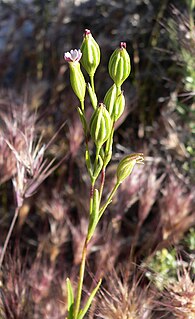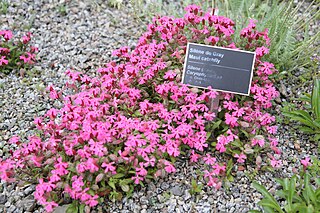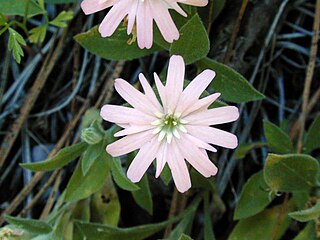
Silene antirrhina is a species of flowering plant in the family Caryophyllaceae known by the common names sleepy silene and sleepy catchfly. It is native to the Americas, where it is widespread throughout North America and parts of South America. It is known in Europe as an introduced species.

Silene bernardina is a species of flowering plant in the family Caryophyllaceae known by the common name Palmer's catchfly.

Silene bridgesii is a species of flowering plant in the family Caryophyllaceae known by the common name Bridges' catchfly. It is native to California, where it can be found throughout the Sierra Nevada and the southern reaches of the Cascade Range to the north, its distribution possibly extending into Oregon. It grows in mountain forests and woodlands. It is a perennial herb growing from a taproot and woody caudex unit, its stem decumbent or growing erect to half a meter or more in height. It is hairy, the upper hairs glandular, making the plant sticky in texture. The lower leaves are widely lance-shaped, up to 8 centimeters long by 1.5 wide. Upper leaves are smaller. Flowers occur in a terminal cyme at the top of the stem, as well as in some of the leaf axils, where they nod or hang like a bell. Each has a hairy, glandular calyx of fused sepals with ten veins. The calyx is open at the tip, revealing five white, pinkish, or greenish petals each with two rectangular lobes at the tip. The very long stamens and three styles protrude from the flower's center.
Silene serpentinicola is a rare species of flowering plant in the family Caryophyllaceae known by the common name serpentine Indian pink and serpentine catchfly.

Silene campanulata is a species of flowering plant in the family Caryophyllaceae known by the common names Red Mountain catchfly and bell catchfly. It may be a synonym of Silene greenei.

Silene conoidea is a species of flowering plant in the family Caryophyllaceae known by the common names weed silene and large sand catchfly. It is native to Eurasia, and it is known in other parts of the world, such as western North America, as a weed. It is an annual growing up to a meter in height with a hairy, partially glandular stem. The lance-shaped leaves are up to 12 centimeters long near the base of the plant and smaller farther up. The flower is enclosed in an inflated, hairy, glandular calyx of fused sepals which is ridged with many veins. It is open at the top, revealing five bright pink petals.

Silene dichotoma is a species of flowering plant in the family Caryophyllaceae known by the common name forked catchfly. It is native to Eurasia and it is known in other parts of the temperate world, such as sections of North America, where it is a weed that grows in disturbed habitat. It is an annual herb growing up to 80 centimeters tall. The lance-shaped leaves are up to 8 centimeters long on the lower stem and are smaller farther up. Each flower is encapsulated in an inflated calyx of sepals lined with ten veins. It is open at the tip, revealing five white to red petals, each with two lobes at the tip and sometimes taking a curled form.

Silene douglasii is a species of flowering plant in the family Caryophyllaceae known by the common name Douglas's catchfly.

Silene grayi is a species of flowering plant in the family Caryophyllaceae known by the common name Gray's catchfly. It is native to the mountains of Oregon and northern California, including the Klamath Mountains, where it grows in chaparral, mountain forests, and the talus of high slopes in alpine climates. It has been observed to occur in a plant association with oceanspray, littleleaf silverback, and Gray's bedstraw. It is a perennial herb producing a decumbent or erect stem up to 20 or 30 centimeters long from a woody, branching caudex. The base of the plant is covered in tufts of leaves. These basal leaves are lance-shaped to nearly spoon-shaped, fleshy, and up to 4 centimeters long. Smaller, narrower leaves occur farther up the stems. Each flower has a tubular calyx of fused sepals lined with ten green or red veins and covered in glandular hairs. It is open at the tip, revealing five pink or purple petals. The petal tips and appendages are divided into narrow lobes.

Silene hookeri is a species of flowering plant in the family Caryophyllaceae known by the common names Hooker's silene, Hooker's catchfly, Hooker's Indian pink, and Hooker's glandular campion.

Silene invisa is a species of flowering plant in the family Caryophyllaceae known by the common names red fir catchfly and short-petaled campion.

Silene lemmonii is a species of flowering plant in the family Caryophyllaceae known by the common name Lemmon's catchfly.
Silene marmorensis is a rare species of flowering plant in the family Caryophyllaceae known by the common names Marble Mountain catchfly, Marble Mountain campion, and Somes Bar campion. It is endemic to the southern Klamath Mountains of northern California, where it grows in mountain woodlands and forests. It is a perennial herb producing several stems and shoots from a woody, branching caudex and thick taproot. The hairy, glandular stems grow erect to a maximum height near 40 centimeters. The lance-shaped leaves are a few centimeters long and are borne in pairs, the lowermost drying early. The inflorescence is a terminal cyme of flowers at the top of the stem, and some flowers may occur in the leaf axils. Each flower has a hairy, veined calyx of fused sepals. The flowers bloom at night, the five pinkish or green-tinged petals opening at the tip of the calyx.

Silene menziesii is a species of flowering plant in the family Caryophyllaceae known by the common names Menzies' campion and Menzies' catchfly. It is native to western North America from Alaska through the western half of Canada to the southwestern United States. It can be found in many types of habitat and it is quite common in much of its range. It is variable in morphology and there are a number of varied subtaxa. In general, it is a perennial herb growing from a caudex, appearing matlike, decumbent, or erect, with stems a few centimeters to over half a meter long. It is usually hairy in texture, with upper parts bearing sticky glandular hairs. The leaves are lance-shaped, oppositely arranged in pairs, and a few centimeters in length, upper leaves usually smaller than lower. Flowers may occur in a cyme at the top of the stem, or in leaf axils, or both. Each is encapsulated in a hairy, veined calyx of fused sepals. The petals are white with two lobes at the tips. The plant is dioecious with male and female plants producing different flowers. The male and female flower types look the same externally; the stamens are reduced in female plants and the stigmas are reduced in the male.

Silene noctiflora is a species of flowering plant in the family Caryophyllaceae known by the common names night-flowering catchfly, nightflowering silene and clammy cockle. It is native to Eurasia, but it is known on other continents as an introduced species and sometimes a weed. In North America, it is a common weed of grain crops in the Canadian prairie provinces and in much of the United States. It grows in fields and in other disturbed habitat.
Silene nuda is a species of flowering plant in the family Caryophyllaceae known by the common names western fringed catchfly and sticky catchfly.

Silene occidentalis is a species of flowering plant in the family Caryophyllaceae known by the common names western catchfly and western campion.

Silene oregana is a species of flowering plant in the family Caryophyllaceae known by the common names Oregon silene, Oregon campion and Oregon catchfly. It is native to the western United States, including the Great Basin, where it grows in habitat such as sagebrush and forests. It is a perennial herb growing from a woody caudex and taproot, sending up an erect, mostly unbranched stem which may be 70 centimeters tall. The lance-shaped leaves are up to 8 centimeters long around the caudex, and shorter farther up the stem. Flowers occur in a terminal cyme and sometimes in leaf axils. Each flower is encapsulated in a hairy, glandular calyx of fused sepals. The five petals are creamy white or pink-tinged in color and each has four to six long, fringelike lobes at the tip.

Silene polypetala is a rare species of flowering plant in the family Caryophyllaceae known by the common names eastern fringed catchfly and fringed campion. It is native to Georgia and northern Florida in the United States. It is threatened by the loss and degradation of suitable habitat. It is a federally listed endangered species of the United States.

Silene regia is a species of flowering plant in the family Caryophyllaceae known by the common name royal catchfly. It is native to the central United States. A perennial herb, it grows from a fleshy taproot and has several erect stems growing up to 1.6 meters tall. The leaves are lance-shaped to oval and up to 12 centimeters long, becoming smaller farther up the stem. The inflorescence is an array of many flowers at the top of the stem. The elongate tubular calyx of sepals is up to 2.5 centimeters long and has 10 longitudinal veins. The lobes of the bright red corolla are 1 to 2 centimeters long.
















